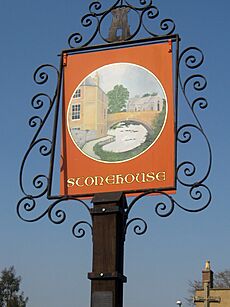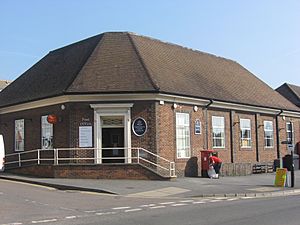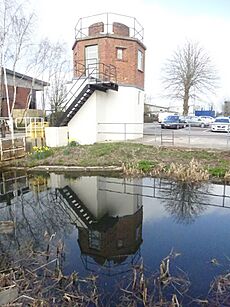Stonehouse, Gloucestershire facts for kids
Quick facts for kids Stonehouse |
|
|---|---|
 Clockwise from top-left: Nutshell Bridge on the Stroudwater Navigation, town high street, Church of St Cyr, Stonehouse railway station |
|
| Population | 7,591 (2021 Census) |
| OS grid reference | SO805055 |
| Civil parish |
|
| District |
|
| Shire county | |
| Region | |
| Country | England |
| Sovereign state | United Kingdom |
| Post town | STONEHOUSE |
| Postcode district | GL10 |
| Dialling code | 01453 |
| Police | Gloucestershire |
| Fire | Gloucestershire |
| Ambulance | Great Western |
| EU Parliament | South West England |
| UK Parliament |
|
Stonehouse is a town in Gloucestershire, England. It is located in the Stroud District in the southwest of the country.
The town center is about 2.5 miles east of the M5 motorway. Stonehouse railway station offers regular train services to London.
Stonehouse is about 9 miles south of Gloucester and 4 miles west of central Stroud. Some parts of Stonehouse now connect with the Ebley area of Stroud. The town also includes smaller areas like Bridgend and Ryeford.
Contents
- History of Stonehouse
- Things to Do in Stonehouse
- Town Growth and Development
- Images for kids
- See also
History of Stonehouse
Stonehouse Manor House
Stonehouse is mentioned in the Domesday Book of 1086. This was a big survey ordered by William the Conqueror. The town was called “Stanhus” back then. People think this name came from the manor house being built of stone. Most houses at that time were made from wood and mud.
William de Ow, a cousin of William the Conqueror, owned the land. His property included a vineyard and two mills. The name “Stanhus” likely changed to Stonehouse over time.
The original manor house was completely rebuilt in 1601. In 1906, Arthur Winterbotham bought Stonehouse Court. He had it fully renovated by a famous architect named Edwin Lutyens. A fire in 1908 destroyed the new inside of the house. However, Winterbotham had it rebuilt in a similar style.
After Mr. Winterbotham passed away, his wife Caroline lived there until 1974. The house was then sold and became a business office. In 1983, it opened as the Stonehouse Court Hotel. It is next to St Cyr's Church and the Stroudwater Canal. Stonehouse Court is a Grade II listed building, meaning it's an important historic structure. Some of the oldest trees in Stonehouse are found in its grounds.
Important Dates in History
- 1327: One of the manor's owners, John Maltravers, was involved in the murder of King Edward II. He had to leave the country but later returned. The Stonehouse manor was given back to him. He paid a single rose each year to show his loyalty to the King. This might be why the Tudor rose is now a symbol of Stonehouse.
- 1375–1558: The Earls of Arundel owned the manor. The Lord of the Manor did not always live there. A manager or tenant often looked after it. During this time, the manor house was a working court. It made decisions for the whole manor. This is when it became known as Stonehouse Court.
- 1558: The Court was sold to local cloth makers, William Fowler and William Sandford. Making cloth was becoming a big job in the area.
- 1601: William Fowler's son, Daniel, rebuilt the manor house. A stone above the door likely marks this new building.
- 1685: The Court was rented out to farmers. The owners lived in grander homes elsewhere.
- 1730: The oldest map of the manor lands was made. You can see a copy of it in the hotel today.
- 1779: The Stroudwater Canal opened. It ran right through the manor lands.
- 1810: Court Farm was built.
- 1847: The Marling family owned the Court.
Local Industries
The wool industry was very important to Stonehouse. People first produced wool and later became skilled in making textiles. Small mills in the 17th and 18th centuries provided work for people at home. Later, this changed to a factory system. When the textile industry became less popular, Stonehouse still did well. Many smaller businesses took over.
Stonehouse also had a brickmaking industry starting in 1856. There might have been brickmaking even earlier, around 1839. In total, there were about thirteen brickmaking sites. The biggest brick company was Stonehouse Brick and Tile Company Ltd. It was founded in 1891. By 1895, it employed many people making pottery, terra-cotta, and bricks.
The company closed in 1968. Its tall, 202-foot chimney was taken down. Bricks from this company were used locally, like in the Stonehouse Post Office (now the Town Hall). They were also used in other parts of Britain. Some even went as far as Cape Town, Gibraltar, and Buenos Aires. The bricks for Gibraltar were carried on the RMS Lusitania ship. The English Clock Tower in Buenos Aires, Argentina, was built with these bricks. In 2016, the Stonehouse History Group sent a special plaque for its 100th birthday.
Today, Stonehouse has several business and industrial parks. The largest one is in Oldends Lane. Here you can find big companies like Müller (a dairy company), Schlumberger, Renishaw, and others.
In 2015, a new business park was built near the A419 road. In 2016, a plan for a new eco-business park and a wooden football stadium was suggested. This would be for the Forest Green Rovers team. The stadium plan was approved in December 2019.
Things to Do in Stonehouse
Canal
You can find many footpaths and lanes from the town that lead to the nearby canal. This is the Stroudwater Navigation, which runs through the west of Stonehouse. On the canal, behind Stonehouse Court, is Ocean Bridge. This was an iron swing bridge where canal boats used to turn around. There was also a boat repair yard there.
The Cotswold Canals Trust is working to restore the canal. They plan to connect it all the way to Saul Junction. There, it will meet the Gloucester & Sharpness Canal. To do this, a new railway bridge was built in 2021. A new canal path will go under the M5 motorway. The A38 roundabout near Fromebridge Mill was also changed in 2021. This means boats will be able to pass under the roundabout. When all this work is done, boats might be able to travel from Saul Junction to the center of Stroud. More work is needed to link this part to the River Thames.
The Ocean area is a great place for wildlife. You can see many ducks, swans, herons, kingfishers, and moorhens there.
Cotswold Way Walking Trail
The famous national walking trail, Cotswold Way, passes very close to Stonehouse.
Sports
The local football club is Stonehouse Town F.C.. It is located in the north of the town. The club has four teams, and its top team plays in the Northern Senior League.
Parks and Play Areas
Stonehouse has three public recreation grounds. These are Laburnham Playing Field, Meadow Road Park, and Oldends Lane. The Oldends Lane park is next to the Stonehouse Football Club.
Green Spaces and Nature Reserve
Near Court View, by the old Stonehouse and Nailsworth Railway, there is a small nature reserve. It is fenced off to protect a group of great crested newts. A sign at the reserve tells you about the wildlife you might see there.
Historic Buildings and Pubs
In the early 19th century, Stonehouse had many pubs. Today, there are two main ones: The Woolpack and The Globe. The Woolpack Inn is one of the oldest buildings in Stonehouse. It was built from 16th-century cottages and barns. It used to serve wool traders and farmers. The Crown and Anchor, now a doctor's surgery, was once the main inn where coaches stopped.
Local Media
Television
Local news and TV shows come from BBC West and ITV West Country.
Radio
You can listen to local radio stations like BBC Radio Gloucestershire, Heart West, and Greatest Hits Radio South West.
Newspapers
The town has a local newspaper called the Stroud News & Journal.
Education
Primary Schools
Stonehouse has two primary schools. Park Infant School is for children aged 5 to 7 (Reception to Year 2). It has about 160 students. Park Junior School is for children aged 7 to 10 (Years 3 to 6). It has about 200 students. Each school has two classes for every year group.
Secondary Schools
Maidenhill School is the town's secondary school. It is for students aged 11 to 16. The school can hold up to 785 students.
Independent Schools
Wycliffe College is an independent school in the south of Stonehouse. It has two campuses: a Preparatory School (which includes a Nursery) and a larger Senior campus. One of the school's boarding houses, Haywardsend, is an old Tudor farmhouse and one of the town's oldest buildings. Haywardsfield is another old boarding house. Some of the town's oldest trees are on the college grounds. New trees have been planted to replace any that were removed due to disease.
Places of Worship
The main church in Stonehouse is St Cyr's Church. It is named after St Cyriac or St Cyril. The church is next to the canal in the west of the town. St Cyr's Church is one of the oldest buildings in Stonehouse. Its tower dates back to the 14th century. George Whitefield, a famous preacher, once spoke here.
Other churches include Stonehouse Methodist Church, St Joseph's Catholic Church, Stonehouse Baptist Church, and the Bethel Church. Stonehouse Live is a group that brings all the churches in Stonehouse together. A Wesleyan chapel was built in 1911 on the grounds of Wycliffe College. It was used by the school and the local Methodist community. A tower and spire were added in 1921. The chapel was damaged by fire in 1939 but rebuilt in the late 1950s. Its tower is a Grade II listed building. The chapel holds popular Christmas Carol Services for the school and local community.
Local Government
Stonehouse has an electoral ward, which is a local area for voting. The population and area of this ward are the same as the parish of Stonehouse.
Police Station
The nearest Police Station is in Stroud. The Stonehouse police station closed in late 2011.
Transportation
Roads
Stonehouse has good road connections. The M5 motorway is within 2 miles of the town center. The main industrial area is to the west of the town, off the A419. The A419 is an important road that connects Stonehouse and the Stroud area to the nearby A38 and M5.
The B4008, also known as High Street, is the main road through Stonehouse. It is also a busy route for people traveling between Stroud and Gloucester. In 2011, Stonehouse High Street was changed to a "Community Shared Space." This means it's designed to be safer and more pleasant for both drivers and pedestrians. It reopened in September 2011.
The High Street has many shops, including a supermarket. The town's Post Office moved into the supermarket in 2017. The old Post Office building is now the library. Stonehouse also has a free car park and public toilets just off the High Street.
Buses
Bus services to Gloucester and Stroud are provided by Stagecoach. There are also services to Cam, Dursley, and the Stanleys. You can find several bus stops throughout the town.
Trains
The town is served by Stonehouse railway station on the Golden Valley Line. This line offers services to London. The station has platforms for trains going east and west, with shelters on each. There is also a pedestrian bridge over the tracks and a small car park. The station does not have staff, so you buy tickets from a machine. There is a campaign to reopen the old Midland Railway Station or build a new one further north. This would connect Stonehouse directly to the Midlands and the South West.
Town Growth and Development
Stonehouse grew partly because of its good transport links. In 1779, the Stroudwater Navigation canal was built. You can still see parts of this old canal today.
Businesses grew even more when land was prepared for new railway stations. The Midland Railway Station opened in 1844, and the Great Western Railway Station opened a year later. The Stonehouse and Nailsworth Railway opened lines to Nailsworth in 1867 and Stroud in 1885.
World War 2 and Factories
Before World War II, factories were moved to safer places away from German bombers. The Cotswolds, including Stonehouse, were chosen. Two important factories were built in Stonehouse: Sperry's Gyroscope Company at Bond's Mill and Hoffmann's Bearings at Oldends Lane. These factories provided many jobs during and after the war.
The Gatehouse at Bond's Mill was built during World War II as a defensive "pillbox." It's a rare two-story building with a gun position on the roof. It is now a Grade II listed building and serves as a visitor center for the Cotswold Canals Trust. Old air-raid shelters are also nearby, used for storage.
German intelligence even photographed the Sperry factory in 1940, planning a raid that never happened.
After the War
After World War II, some railway lines closed. Passenger services on the Stroud and Nailsworth branch stopped in 1947. The Midland Railway station closed in 1965. The Burdett Road station (now Stonehouse railway station) was almost closed in 1972 but stayed open.
Stonehouse became connected to the national motorway system in 1971 when the M5 motorway opened. In the late 20th century, Stonehouse saw a lot of growth in industry. Large international companies moved into the area.
New houses were also built in Stonehouse after the war. The Park Estate was built in the 1950s, and other areas like Little Australia and Boakes Drive followed. Housing development continues into the 21st century.
In 1986, an outbreak of meningitis in Stonehouse led to the creation of The Meningitis Trust. This charity, now called Meningitis Now, has funded a lot of research to prevent the disease.
Images for kids
See also
 In Spanish: Stonehouse (Gloucestershire) para niños
In Spanish: Stonehouse (Gloucestershire) para niños






